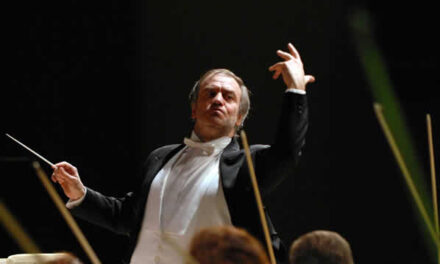Arvo Pärt, Cantique des degrés, Stabat Mater, Symphony No. 3; RIAS Kammerchor, Rundfunk-Sinfonieorchester Berlin, Kristjan Järvi, cond.; SONY Classical, 88697753912, ©2010, 59:47, $11.98, http://www.sonymasterworks.com/
This is an “occasional” CD; that is to say, it is issued for a special occasion, namely the 75th anniversary of the birth of the composer. It is also the celebration of a longstanding friendship and professional relationship between the composer and the conductor, and the latter’s family. Both are Estonian, and both families left their homeland in the face of Soviet oppression, within days of each other in 1980, going to Vienna. They subsequently went in separate directions: the Järvis to the USA and the Pärts to Berlin after the fall of the East German Communist state, but they continued to remain in regular contact.
The two choral works that surround the symphony are themselves “occasional” pieces. The Stabat Mater was commissioned by the Alban Berg Foundation for the centennial of the birth and 50th anniversary of the death of that composer; it was premièred in Vienna in 1985. The Cantique was commissioned by Princess Caroline of Monaco for the 50th anniversary of the accession to the throne of her father, Prince Ranier III, and was premièred in Monaco in 1999. Both were subsequently revised extensively, and the Stabat Mater uses greatly expanded forces in this version.
The history of the works also demonstrates some of the composer-conductor inter-personal connections. Kristjan Järvi’s father Neeme is the dedicatee of the symphony. Kristjan conducted the première of the revised version of the Stabat Mater, commissioned by the Tonkunstler-Orkester, of which he was then the principal conductor, in Vienna in 2008, with Pärt present, as well as its first German performance in Berlin with these forces in 2009. The RIAS Kammerchor [= Radio In the American Sector Chamber Choir] was founded in 1948 after the post-WW II partition of Germany; The Rundfunk-Sinfonieorchester Berlin [Berlin Radio Symphony Orchestra] dates from 1923. While both organizations were created for live radio broadcasts, both now have extensive schedules of performances in public halls and are highly esteemed, receiving prize-winning recognition for their recordings. Their performances here live up to their reputations. (Back in the day, CBS, whose recording division is now part of SONY, and NBC had their orchestras, too: the Columbia Symphony Orchestra and the NBC Symphony respectively, and they were well regarded with some big-name conductors – Bruno Walter for the former, for example, whose Beethoven set on LP was highly esteemed, and was many a collector’s first one, but these orchestras bit the dust long ago.)
Pärt experienced a period of compositional roadblock from 1968 to 1976. His earlier music was in the modern, avant-garde experimental style, but after intensive study of Gregorian chant, the 12th century Notre Dame (Paris) school of polyphony, and Renaissance and Classical vocal polyphony, he settled on what he calls the tintinntabuli (plural of tintinnabulum, bell in Latin) style, that is dominant in both choral works here, especially in the Stabat Mater. Cantique des degrés is the French equivalent of Canticorum graduum (Song of the steps, as in a procession or a staircase), the original title of Psalm 121, whose opening line: “I will lift up mine eyes unto the hills” was the source of the text Mendelssohn used in the famous Trio of Angels in Elijah. The Symphony No. 3, written in 1971, is his sole work from the otherwise silent years.
If the CD and some of the works are celebratory, the style of the music is not. It is what we have come to perceive as typical Pärt, minimalist, using sparse materials, harmoniously melodic, generally peaceful and serene, sometimes ethereal often building to occasional climactic moments. The order of the program is as well crafted as the individual works, beginning with the Stabat Mater, the longest piece, which begins in hushed tones and where the bell-like triads are clear and pronounced, as they also often are in the Symphony, where there are more climactic moments, and building to the climax of the Cantique, which although the shortest, is the most complex of the pieces because the triads are more adroitly embedded.
The notes (in three languages, German original) by Guido Johannes Joerg in the accompanying booklet are informative and well written. Several black and white photos of Pärt and Järvi are scattered throughout, along with a single side view of the orchestra in rehearsal or recording session, and color ones adorn the two covers, together on the front, Järvi alone on the back; there is none of the choir, however. Track listings and timings (although the reader has to total those of the 3 movements of the Symphony to get its total play time) and credits are on page 3. The texts of the choral works are not provided, however. These oversights compromise the otherwise fine quality of the product. Highly recommended.












